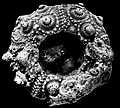The Echinoid Directory
Paurocidaris Kier, 1977, p. 18
| Diagnostic Features |
|
|---|---|
| Distribution | Late Triassic (Carnian); Italy. |
| Name gender | feminine |
| Type | Cidaris rinbianchi Zardini, 1973, p. 11, by original designation. Holotype: Museo di Cortina d'Ampezzo, Italy, 125-M-Z. |
| Species Included |
|
| Classification and/or Status |
|
| Remarks |
|




